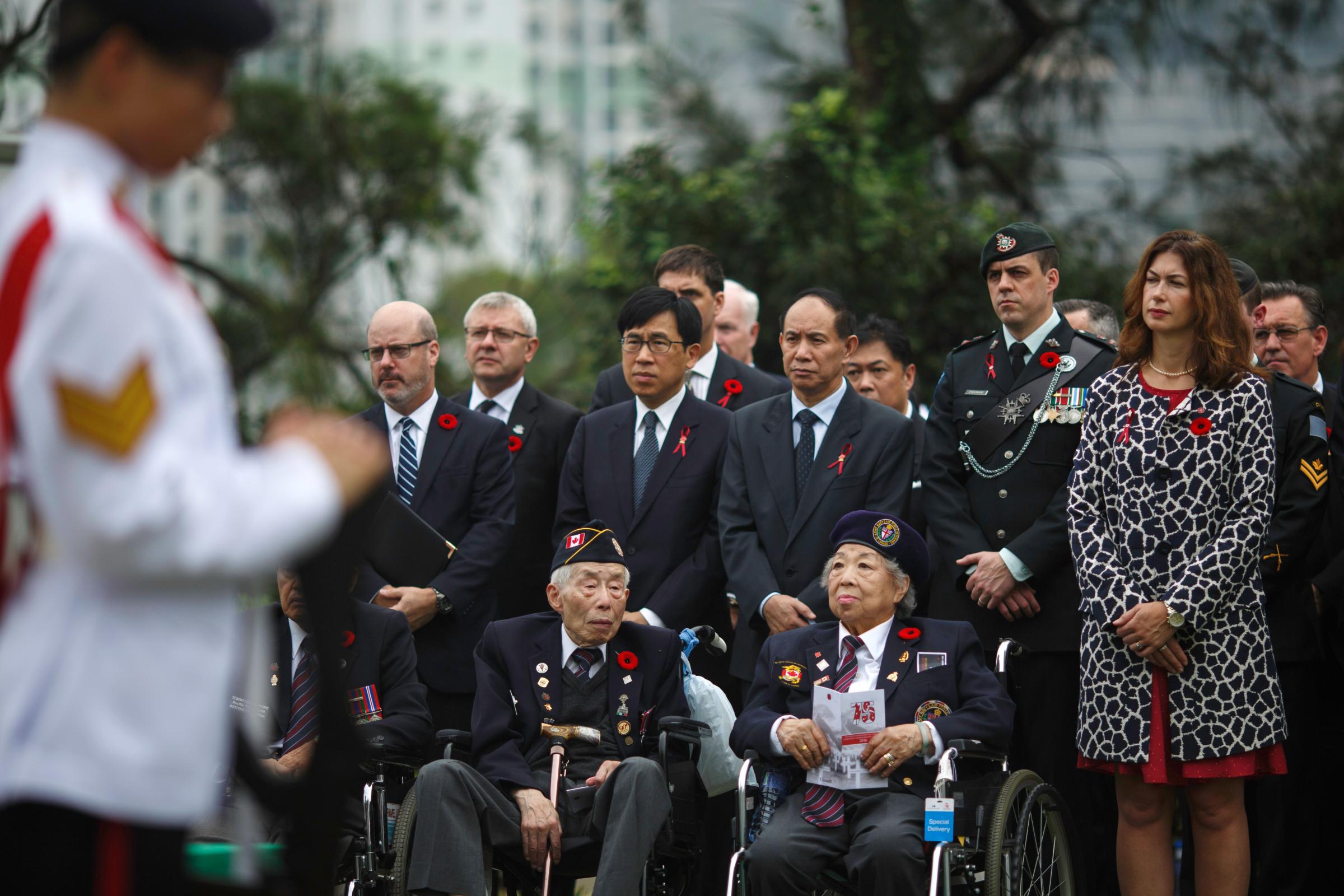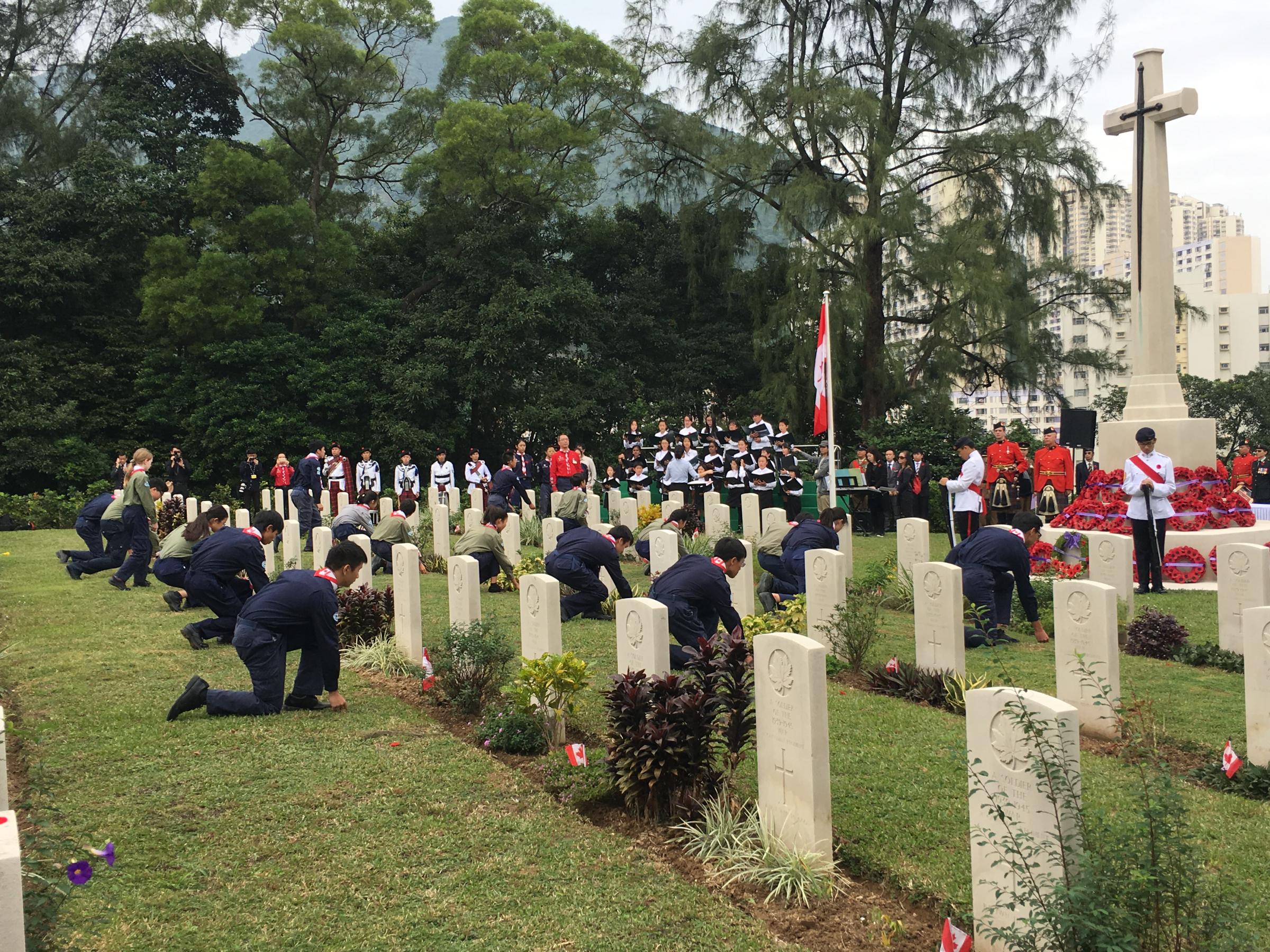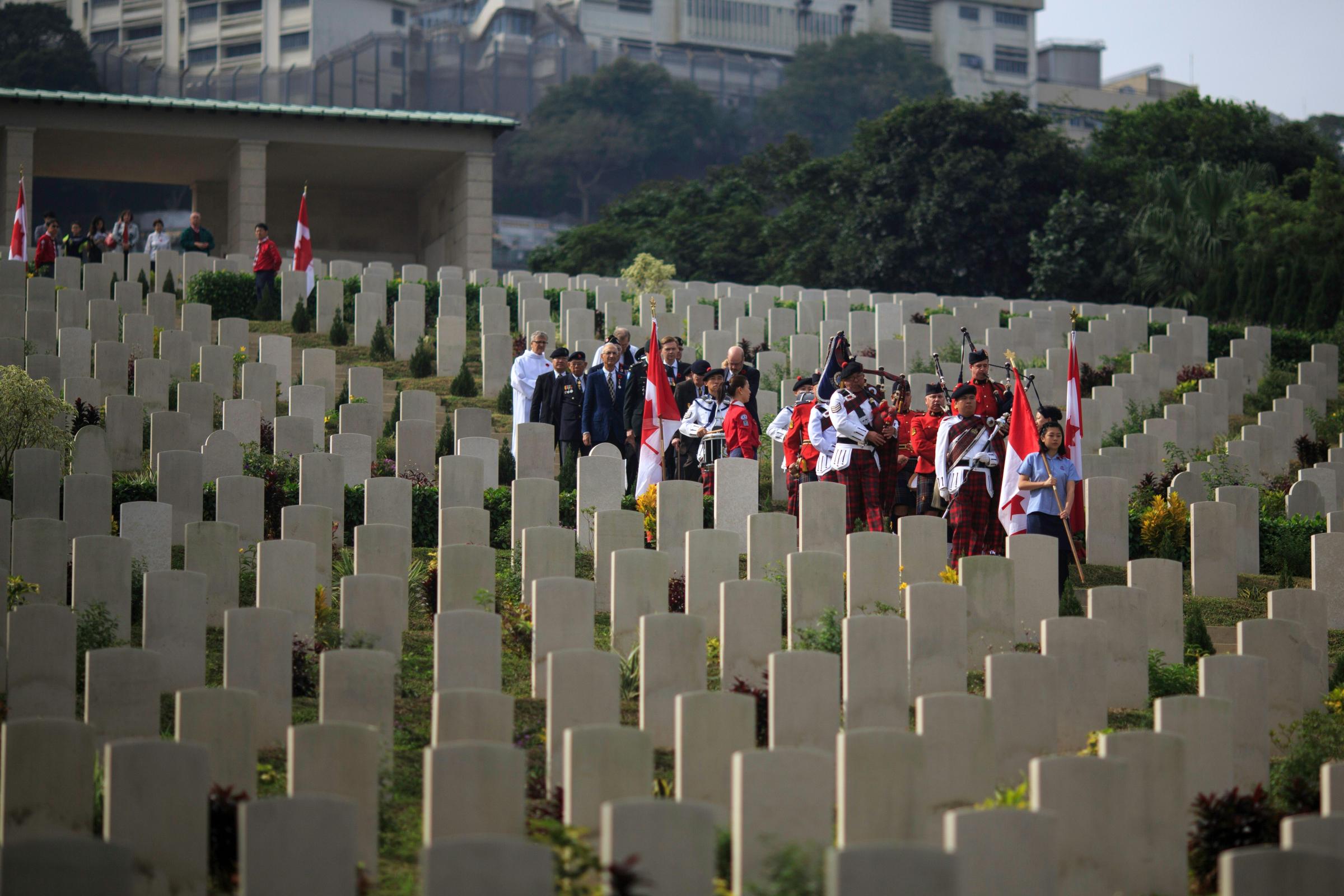
Correction appended Jan. 18, 2016
Hong Kong migrants may have become numerous in the suburbs of Vancouver, but there is a part of Hong Kong that is forever Canada.
To find it, you need to climb the lush uplands of Hong Kong Island’s eastern tip to Sai Wan War Cemetery. The remains of 283 Canadian servicemen are buried here, their role in the World War II defense of Hong Kong little understood, or even known, by the multitudes inhabiting the residential blocks and industrial buildings of the waterfront below.
At about this time 75 years ago — in January 1942 — 1,689 of their comrades who had survived the Battle of Hong Kong were being marched by victorious Japanese forces to the North Point prisoner of war camp, some 8 km from where the cemetery is located today. Another 264 Canadian soldiers were to die in Japanese captivity.
Nothing remains of the camp, and no memorial or plaque has been erected on the site, which is presently occupied by part of the King’s Road playground. That means that those commemorating the fallen Canadians in the 18-day Battle for Hong Kong focus their devotions almost exclusively at Sai Wan — the site of pilgrimage by surviving veterans and their families, as well as by Prime Ministers coming to pay respects, the most recent being Justin Trudeau, who visited last September as part of his trip to China.
The crowd was particularly numerous on Dec. 4, 2016 — virtually 75 years to the day that a ravaged Hong Kong capitulated to the Japanese on Christmas Day 1941. “This is part of our Canadian heritage,” a woman told her young child as they entered the cemetery.

During the battle, a combination of troops from Britain, Canada, other parts of the British Empire, as well as local Hong Kong soldiers, fought tooth and nail to defend the colony from Japanese troops moving southward from the Chinese mainland, parts of which had already fallen in the ongoing Second Sino-Japanese War.
“It was here, on Dec. 8, 1941, that Canadian troops experienced our country’s first battle in World War II,” Jeff Nankivell, the Canadian consul general in Hong Kong and Macau, said at the Dec. 4 gathering. “The ultimate sacrifices” made by Canadian troops, he added, “helped to build the unique and strong bond between Canada and Hong Kong.”
Among the over 14,000 Allied soldiers trying to fend off the invaders were two battalions from Canada, the Winnipeg Grenadiers and the Royal Rifles of Canada, totaling 1,975 men. Many of them were, at that time, deemed unfit for combat because of their lack of training. Despite that and many other disadvantages, they still managed to put up a stiff resistance during the battle, and caused considerable Japanese casualties.
At least four surviving war veterans were present at the ceremony. One of them was Peter Choi, a Hongkonger who saw active combat during the battle. He said he’s attended every year’s commemoration ceremony since the war ended.
“There wasn’t much fear to speak of,” he recounted his wartime memories to reporters at the ceremony. “One either lives or dies in battle.”
Another Chinese-Canadian veteran at the ceremony, Tommy Wong, saw action not in Hong Kong, but in nearby Burma and India as the war raged on. Recruited as Japanese forces advanced through Southeast Asia, he became part of a clandestine British unit dropped into Burma to assist local resistance efforts in fallen areas.
“The chances of coming back [were] very slim,” he recalls.

‘It’s like their ANZAC Day’
Though few in Hong Kong speak today of the city’s Canadian defenders, the Battle of Hong Kong is far from forgotten in Canada. For one thing, Canada suffered hefty losses in Hong Kong. Almost 30% of the contingent did not live to return to Canada when peace came in 1945.
As Canadian historian Galen Perras explains to TIME via email, Hong Kong “was the sole Canadian army effort in the Pacific” for a considerable time during the war.
Canada’s emphasis also has to do with its own national identity, according to Kwong Chi-man, a Hong Kong historian focusing on East Asia and military history.
“It’s like their ANZAC Day in a sense,” he tells TIME, referring to Australia and New Zealand’s commemoration of their defeat in the Battle of Gallipoli during World War I. He adds that Canada’s misadventure was part of “the making of a Canadian identity separate from the British.”
In total, over 2,000 people from Allied nations died trying to protect an outpost that, according to Winston Churchill in January that year, had “not the slightest chance” of being retained if war with Japan broke out. Seen in this light, the Canadians, and other defenders, were doomed from the start and Churchill’s motives have been scrutinized ever since.
Some suggest that the deployment of the Canadians was meant as a gesture to inspire confidence in the Churchill’s allies that the U.K. was capable of meeting its imperial obligations and wouldn’t cede territory without a fight. Others believe the Canadians were there as a deterrent, to prevent the Japanese from striking. They add that a Japanese attack, were it to materialize, wasn’t expected till much later, allowing time for the untrained Canadians to be brought up to speed.
The view that Canadian soldiers were essentially tricked into their graves in Hong Kong was given prominence in the Canadian documentary Savage Christmas, part of the controversial 1992 series The Valour and the Horror, which examined the country’s World War II involvement.
“Obviously, in hindsight we know [the move] was wrong,” Tony Banham, a Hong Kong historian who has written extensively about the battle and its aftermath, tells TIME by email. But had forecasts of Japanese hesitation to invade Southeast Asia been right, “then the battle readiness of these battalions would not have been a major factor — they would have been there for show.”
Ottawa, it must be said, was a very willing partner in committing nearly 2,000 men to East Asia. In his November 1941 diary entries, the then Canadian Prime Minister William Lyon Mackenzie King wrote about the deployment thusly: “Defense against aggression anywhere [is] defense of any country enjoying freedom today,” and “for Canada to have troops in the Orient, fighting the battle of freedom, marks a new stage in our history.”

“Inactivity [of Canadian troops deployed overseas] had become a political problem in Canada” by 1941, remarks historian Perras, noting that, prior to Hong Kong, most Canadian servicemen had simply been on garrison duty.
Whatever reason for the Canadian deployment, one thing is certain: the ranks of veterans and survivors from the Battle and the war are growing thin. As the veteran Wong tells TIME after the ceremony at Sai Wan, it is important for him to be there on key anniversaries, to honor his compatriots and their sacrifice.
“We’re not getting any younger,” he says.
— With reporting by Helen Regan / Hong Kong
Correction: The original version of this article stated that the Canadian defenders of Hong Kong were conscripted. They were not.
More Must-Reads From TIME
- The 100 Most Influential People of 2024
- Coco Gauff Is Playing for Herself Now
- Scenes From Pro-Palestinian Encampments Across U.S. Universities
- 6 Compliments That Land Every Time
- If You're Dating Right Now , You're Brave: Column
- The AI That Could Heal a Divided Internet
- Fallout Is a Brilliant Model for the Future of Video Game Adaptations
- Want Weekly Recs on What to Watch, Read, and More? Sign Up for Worth Your Time
Contact us at letters@time.com